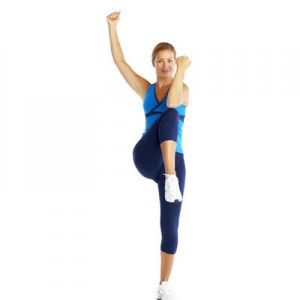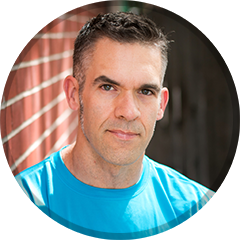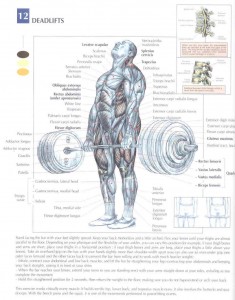This is a quick update to my recent plantar fasciitis posts (Part I and Part II.) I met recently with Denver-area Z-Health movement specialist Brain Copeland and it seems he may have helped me find a titanic breakthrough in my PF! Briefly, he assessed whether or not my arms and legs were coordinated properly during gait. He used muscle testing as part of this assessment. Turns out I had really only been cheating at walking and chewing gum. My gait looked normal enough but I was weak in certain positions where I should’ve been strong, and I was strong in some positions where I should’ve been weak. He then introduced cross-crawl patterns to me. Since then, my PF pain has decreased significantly and it has stayed that way. (I saw him on Saturday and this is Wednesday.) In some circles, this is known as a “WTF?” moment.
“Imagine you hire three people to work at a company to perform three separate jobs. But two of the employees are trying to do the same job and the third job is getting neglected. This is how I envision neurological disorganization.” Brian Copeland, Z-Health Movement Specialist

Goofy? Yes. Effective? Also yes!
The Cross-Crawl
Cross-crawl patterns are, as the name implies, movement patterns that resemble crawling. That is, the right arm and left leg converge and vice versa for the left arm and right leg. These are remarkably easy patterns and they can be created while standing, seated, prone or supine. Some of this stuff resembles some goofy old-school “aerobics” class movements (‘Knee to elbow everyone!!”) The supine cross-crawl looks like the “dead bug” ab exercise while the prone cross-crawl is essentially the same as the “bird-dog” low-back rehab exercise. Still another version looks like some sort of Irish jig. Fun stuff right?! (The good news is these moves are really easy and at least in my case, very powerful.) I’ll post video of cross-crawls soon.
What’s at Work Here?
I asked Brian Copleand several questions:
Q: Who might benefit from cross-crawl patterns?
A: “Everyone can benefit from cross-crawling patterns as the movement helps strengthen certain neural pathways in the brain that are beneficial. For instance, when you run, jog or walk and you step forward with your right leg which arm swings forward? It better be your left or you are a toy soldier. This cross lateral pattern of movement is key in both athletes and non-athletes. If you ever see a martial artist throw a very powerful kick with their right leg you will see their right arm go back and left arm come forward. This has to do both with rotational force and rotary stability in the trunk to maintain balance. So cross crawling movements are basically a part of our everyday lives. When the movement patterns become switched then we see all number of strange neurological issues arising such as unexplained pain that has no pathological explanation, clumsiness, troubles with memory and other cognitive issues depending on the severity of the neurological switching.”
Q: How do we identify those who may have this neurological switching?
A: “There are some specific tests that a Level 4 Z-Health Exercise Therapist can give to ascertain if someone has neurological disorganization and no one should self diagnose, but having said that people can get an idea if they have this by looking for the following things. Typically someone will have had some head trauma at one point in their life, even if it was as a child. People might be socially awkward and not know why. People may have a hard time remembering things and have to be shown something over and over again. People will often say things like, ‘things always work different for me than other people,’ and they don’t know why. Frequent clumsiness is a possible indicator as well.”
Q: What do cross-crawls achieve? Can you describe what these patterns do for our brains?
A: “Well that is the $64,000 question. Researchers are still discovering the how and why but for now we know that it does work. As I’ve been told before, science is the observation of repeatable phenomenon. So even if we don’t have the full picture yet we know that it works. But if I may hypothesize just a little… It is classically understood that the left hemisphere of the brain controls the right side of the body and vice versa, there is some variance in there but as a general rule it is true. We also know that many of the natural movement patterns that we have are cross-lateral in nature, in other words right leg, left arm and vice versa. These patterns help to stabilize our torso and provide balance and efficiency of movement. Now imagine if all of a sudden the right hemisphere of your brain decided that it would control the left side of your body, except it would also control the right thumb but not the fingers. Now the left side of the brain is having signal feedbacks or misfires as it tries to control your right thumb. Now the pre-cognitive brain (the automatic part that controls the behind the scenes stuff) encounters confusion and we reach what Z-Health founder Dr. Eric Cobb, D.C. calls a threat response. I can already tell that I am about to open a whole can of worms so I’ll digress a little. Imagine you hire three people to work at a company to perform three separate jobs. But two of the employees are trying to do the same job and the third job is getting neglected. This is how I envision neurological disorganization.”
Q: What else should we know about cross-crawl patterns?
A: “Well there is always more to know but it can become quite complex. I would just say make them a part of your daily warm up for your exercise routine, 20 or so should suffice as preventative medicine. If you have neurological disorganization you may need to do more reps than that. And ultimately each person will respond uniquely different, the amazing and frustrating thing about the human body.”
“Folks can learn a little more about Z-Health and how the human nervous system has an impact on both the pain we feel and our potential for athletic ability by checking out these articles: What is Z-Health and Why It Works and How to Eliminate Pain, Stiffness and Weakness Forever.”
So that’s a fairly thorough discussion on cross-crawling and why it may work. I don’t want to promote cross-crawling as a magic cure-all panacea for everyone. That said, these are very easy movements to execute and they may very much be worth a try. If you have lingering pain that isn’t responding very well to treatment, give cross-crawling a shot. In my case I’ve had tremendous results. (Now of course the challenge is to remain conservative as I add back in running, biking, etc. The temptation is to ramp up to 1000 mph. Not a good idea.)
Further information on cross-crawl patterns can be found at the following sites: Head Back to Health, Natural Health Techniques.


